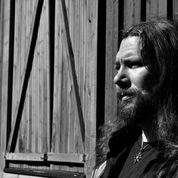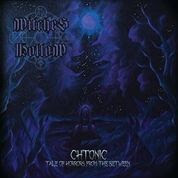1.For those that have never heard of you before, can you tell us a little bit about the band?
In mundane terms, Häxkapell is a creation that plays sombre, aggressive and beautiful music, or black metal of death if you will. Going a bit deeper, it is a vessel dedicated to the search for the truth that lies beyond our mortal world and comprehension. Having played in several bands and styles since the 90’s, some years ago I felt the need to create something solely of my own, and through it channel the energies, emotions and ideas that I find on the longest journey, the journey inwards. So the core of Häxkapell is introspection and transcendence, which is then sonically harnessed into the music closest to my heart: triumphant, epic hymns with strong Nordic roots, where both melancholy and hostility have their place.
2.You have a new album coming out in October, can you tell us a little bit more about the musical style that you went for on the recording?
Most would probably categorize “Eldhymner” as melodic black metal, but for me that’s only the tip of the iceberg. Sure, the foundation is somewhere in that ballpark, but there are also touches of Scandinavian folk music, classical music of the romantic period, heavy metal from the 80’s, darkwave ambience etc. The violins, for example, paint with decidedly Nordic colours and give an emotional depth guitars, for example, can not. Of course, most songs are shock-full of riffs and melodies that harken to the Scandinavian black/death metal scene of the 1990’s, and the forceful yet spontaneous drums hammer out harsh metal beats. It’s my chosen field, after all.
3.You refer to your music as being 'psychographic black metal', can you tell us a little bit more about this term?
I can’t delve too deep into that well, as the good folks at Nordvis came up with that term, not I. But I’m sure its origins lie in the method I often deploy for lyrics, which is automatic writing, or psychography. More on that later. The black metal tag is also a simplification, as discussed earlier.
4.What are some of the lyrical topics and subjects the band has explored so far with the music?
“Eldhymner” is a concept album centring around the theme of fire. Fire is an element with many faces: it can be a destroyer, a bringer of life and light, a dangerous deceiver, a beautiful friend. On my quest for ideas, words and potential secrets from the ether on my inner voyage, I succumb further into the well of the soul, and humbly channel what is given to me. Then, the sculpting and moulding begins, as the potential is unlocked from these extractions of the mind. Through a filter of my own pantheistic worldview, both philosophical, occult and spiritual subjects are contemplated, and religious idols such as Satan and the Sun are invoked, though not in the way of fundamentalistically dualistic worship that is typically found in black metal. Häxkapell is not bound to that one genre, or any religion, instead reaching for something more complete and total.
5.I have heard that some of the lyrics where written through automatic writing, can you tell us a little bit more about this process?
Automatic writing is a method of writing I discovered when I was a kid. The point is essentially to let the unconscious do what it wants, and not interfere in its business with conscious thoughts. Nowadays, after many years of practice, I can guide the subject matter a lot more than in the beginning, when whatever could come out. Depending on how much I want to influence the process, I meditate on the theme, atmosphere, feeling, colour, mindset, whatever it is I want to infuse into the text for, anywhere between a few seconds to a couple of minutes, switch off the brain and let go. Pen meets paper, words are scrawled upon it, and though I don’t know from where it comes, I’m sure it’s from something extraneous that is also within. In pantheism, all is one, all is linked. Sometimes the writings make sense, sometimes they don’t, but more often than not I find ideas I’m positive I’d never be able to conjure from my own mind. I’m just grateful I’ve found a way to receive them.
6.What is the meaning and inspiration behind the name 'Häxkapell'?
Häxkapell is Swedish for “chapel of witchery”, and signifies the sanctuary or shrine one builds within one’s mind, where the Great Work is done. Through its windows, or eyes of the soul, shine the rays of the light of the Truth, nurturing the fruits of knowledge, enlightenment and wisdom. In this chapel, introspection and contemplation is done, and the results built into existential monuments, thus solidifying the development and growth of both person and subject, and paving the road for coming journeys even deeper within.
7.Can you tell us a little bit more about the artwork that is presented on the new album cover?
The cover painting was done by J Edward Neill, a gifted American artist whose work I by chance happened to witness online. Though his other works certainly are beautiful, this particular one instantly resonated with me and perfectly encapsulated the atmosphere of “Eldhymner”. Bleak, vast, menacing, powerful. I just had to have it, and now the original painting adorns the wall of the Häxkapell studio. The logo was made by Luciana Nedelea, and the final touches to the artwork were done by my good friend Andreas of Nordvis.
8.Has the band had any opportunities to do any live shows or open to the idea?
No live shows yet with Häxkapell, but I’m looking into putting together a line-up for concerts. Having done a fair number of gigs with other constellations, I know that living on a tour bus is no dream of mine, but I do enjoy the time on stage immensely. So Häxkapell will never be a band frequently touring the world but playing certain select few events is certainly an enticing possibility.
9.On a worldwide level how has the reaction been to your music by fans of black metal?
Thus far very positive, the few reactions I’ve yet to hear. The release of “Eldhymner” is still a month away, and the demo I made in 2016 wasn't promoted at all. The feedback that has surfaced, though, has been mainly of the approving kind.
10.Where do you see the band heading into musically during the future?
The roots and foundation will probably always stay the same for Häxkapell, but looking ahead to the next chapter, I see a little bit more earthen folk, and also dissonant malignancy. Dynamics and contrasts are important aspects of Häxkapell’s sound, and will be manifested in the future as well.
11.What are some of the bands or musical styles that have had an influence on your music and also what are you listening to nowadays?
Several albums that were important during my teenage years in the mid-90’s have probably had a big impact on “Eldhymner”, such as the first three Satyricon albums, the first two by Dissection and Emperor, Limbonic Art’s debut, early Marduk, Sorhin, Naglfar, Covenant, Isengard, Decameron, Throne of Ahaz…the list goes on. Aside from these records that are roughly in the same genre as Häxkapell, I can also hear inspiration from acts such as Uriah Heep, the Moody Blues, Änglagård, Landberk, and also composers such as Arvo Pärt, Samuel Barber, and J.S. Bach. What am I listening to nowadays? Well, the last week I’ve been spinning a lot of Ildjarn, Sort Vokter and Ved Buens Ende, as well as Mike Stern, Pergolesi and the Prodigy. Schizophrenic? No. Varied? Yes.
12.Before we wrap up this interview, do you have any final words or thoughts?
Thank you for the interview, all the best to the future for you. “Eldhymner” is out on October 29th through Nordvis, if you’re interested in a touch of the past and a glimpse of the future, tune in!





















